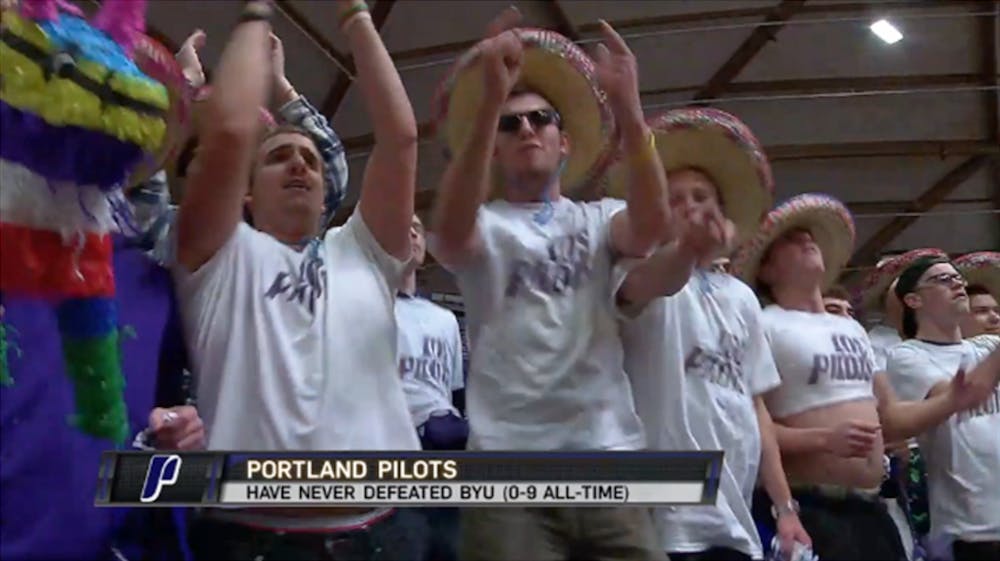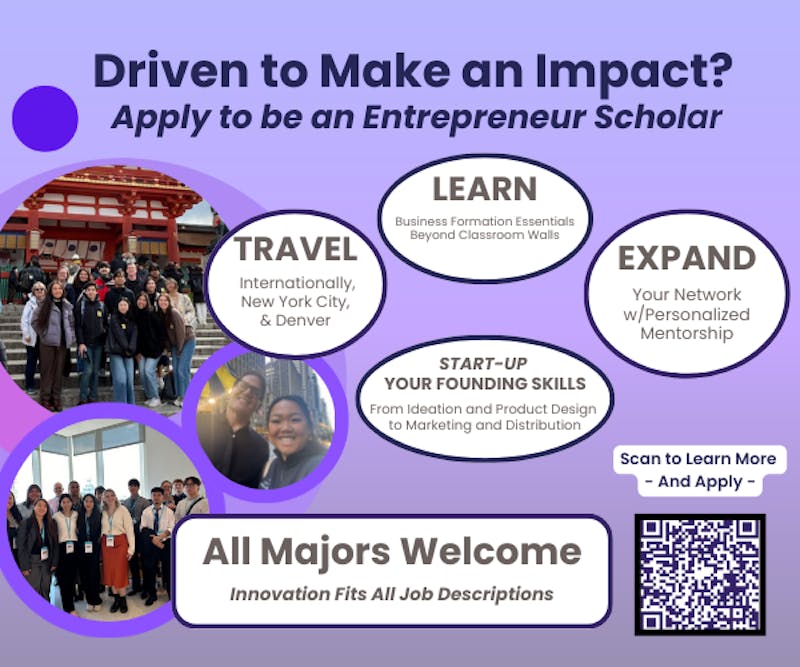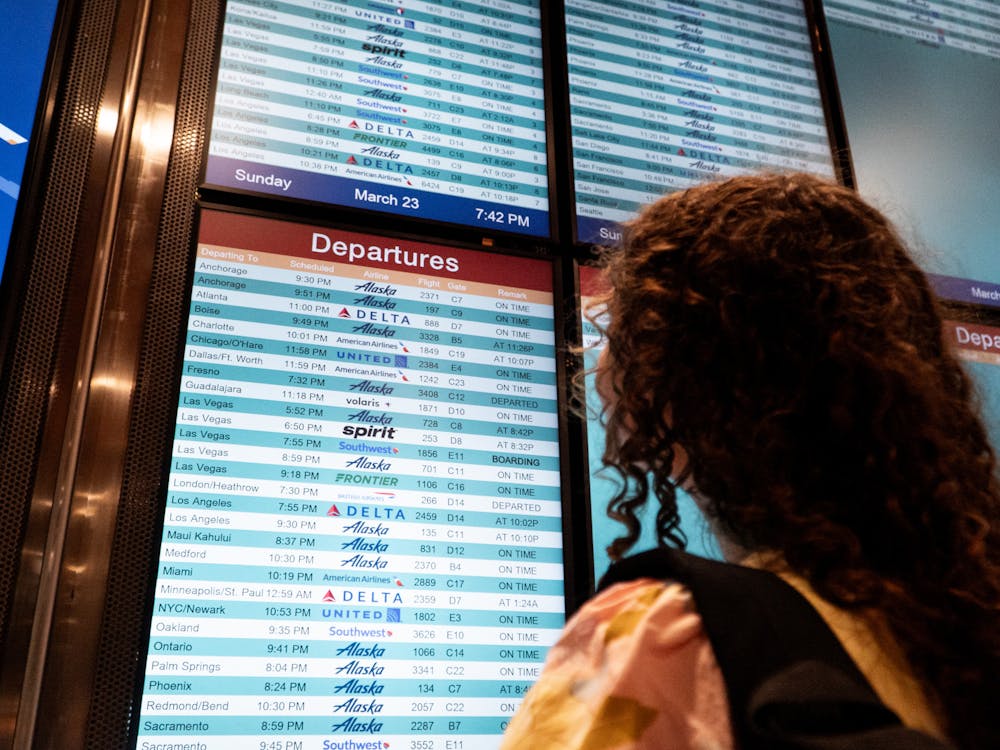By Lydia Laythe |
As 10 pairs of sneakers screeched down the court and the sound of dribbling echoed through the Chiles Center at the game against BYU last Thursday, the voices of the Pilots student section roared above it all. The Pilots would go on to defeat BYU in triple overtime and UP fans would swarm the court.
But amid the excitement, some in the student section felt anything but elated. For them, an incident in the stands resulted in hurt, anger and determination to bring attention to the need for more cultural inclusion and sensitivity at UP. Through word of mouth and social media, the incident led to a larger ongoing dialogue about why not all students feel welcome at UP.
The Incident
The Villa Drum Squad was leading the Pilots fan section as usual, but something was different. The students, along with several friends from other residence halls, wore sombreros and a Mexican flag, and held a piñata and maracas. Several members of the group called out words and phrases in Spanish like: “Si se puede!” which means “It can be done!”
While squad members later said they intended to project an image of Pilot pride, the “Latin-themed” hats and props in that context were condescending and offensive to juniors Yuri Hernandez and Jaclyn Sisto.
The students in sombreros also called out Spanish words like “Arriba!” and the Spanish swear word for “whore.”
“Instantly I just felt disgusted, hurt, and I just really couldn’t believe what I was seeing,” Hernandez said.
Hernandez recognized one of the sombrero-wearing students as a former Service and Justice Coordinator whom she had worked with. When Hernandez asked to speak with the student, he refused.
She attempted several times to explain why she was offended, but became discouraged. That’s when Sisto spoke up.
“I just wanted to have an honest conversation with the people involved,” Sisto said. “(I explained that they were) boiling our culture down to these few things that are very Americanized and very commodified.”
Hernandez and Sisto asked that the students put down their maracas and piñata and remove their sombreros. Yet while the students put down their props, the sombreros remained.
“If it hadn’t been in that context, (the sombreros) wouldn’t have been offensive,” Sisto said.
But the sombreros remained. Hernandez continued to ask the students to remove them.
“At this point, another kid next to my former coworker grabbed the flag, rolled it up in a ball and just chucked it at my face,” Hernandez said. “That’s when I broke down and started crying. And I left. For someone to feel that much disrespect toward me to throw something at my face was just my line. I couldn’t be there anymore. I felt like my culture was literally balled up and thrown in my face.”
After the incident, Hernandez and Sisto emailed and met with faculty, staff, the Villa Maria hall director, the athletic department, ASUP and student club leaders and students to discuss the incident and steps in moving forward. According to a statement released by the Villa residents involved, they “are attempting to resolve this issue directly with Jaclyn and Yuri.”
Sophomore Senator Temo Ledua, a member of the group of students in sombreros, apologized publicly to Hernandez and Sisto at the ASUP meeting Monday, where the incident became the main topic of discussion.
“It really wasn’t our intent to offend anyone or poke fun at a certain culture,” Ledua said. “It’s not because we’re just (a group) of mean boys, it’s a lack of education about cultural insensitivity.”
Villa Maria Hall Director Kurt Berning acknowledged the need for more direct dialogue between the Drum Squad members involved and the two students.
“We want it to be on their terms,” Berning said. “Whatever they’re comfortable with is fine. That hasn’t happened yet, but I think in time there will be some direct communication.”
The Big Picture
Cultural insensitivity is an issue that extends beyond the UP campus. From Penn State to Cornell, colleges across the United States are grappling with similar problems. At Cornell last November, students were outraged by poorly chosen Halloween costumes: sombreros, kimonos and feather headdresses, to name a few. The offended students reacted, starting a campus-wide discussion. The Huffington Post called 2013 “The Year of Cultural Appropriation.”
This incident is not the first of its kind at UP either. Hernandez herself recalled another episode at a Pilots After Dark event in which students yelled homophobic and racial slurs at her and her friends. While the event at the basketball game was the tipping point for Hernandez and Sisto, they said the regularity with which cultural insensitivity occurs at UP makes this a problem beyond the Latino population on campus.
“It’s a bigger picture,” Hernandez said. “It’s beyond us.”
“It’s definitely not an individual problem,” Sisto said. “It’s the culture on campus. The culture on campus is not safe and is not inclusive for everyone. It’s too big of an issue not to make it an issue here on campus for everyone – not just minorities, not just Latinas – everyone, across the board.”
Philosophy professor Alejandro Santana agreed.
“Based on my experience and people that I’ve talked to, it happens with enough frequency that people in underrepresented groups or minorities, students of color, feel that UP is not a welcoming place for them,” Santana said.
Multicultural Programs Coordinator, Bethany Sills, said UP can do more to develop cultural awareness on campus.
“Cultural insensitivity happens all the time,” Sills said. “And we need to build an awareness about that.”
Santana also sees the need for institutional change.
“It seems that this is a good occasion (for) the higher level of the administration to really make this a part of the institutional agenda,” Santana said. “Institution-wide attempts to make this a more welcoming place would involve reaching out to underrepresented groups and saying ‘What would you like this institution to do? What would make you feel more welcome?’”
Moving Forward
Hernandez said the first step to make everyone feel welcome is to assess the structures already in place.
“We have a nondiscrimination policy that includes race and identity,” Hernandez said. “But is it enforced? Are we critically analyzing these policies? There are structures put in place that could’ve prevented this but failed to do so.”
Beyond those structures, such as the Student Code of Conduct or the Nondiscrimination Policy, Hernandez says the faculty, staff and students have a responsibility to intervene. Hernandez and Sisto agreed that the lack of education and training around this issue makes intervening more difficult.
“Let’s take an educational stance,” Hernandez said. “Let’s critically look at it and see how we can make it better. How do we move forward to make this a better place?”
Sisto posed several questions she thought the community should be asking such as “what are we doing to celebrate culture rather than appropriate it?”
ASUP President Quin Chadwick, who also lives in Villa but was not part of the group in sombreros, said he too hopes to use this incident as a learning experience.
“This is an opportunity for us to learn and to grow together – not only as a community, but as a campus, as a whole, and to be more aware of these things and to appreciate those differences and those values that each of us has,” Chadwick said.
In the end, Sisto and Hernandez don’t want an apology or any punishment for the students involved in the Chiles incident.
“We don’t want it to seem like ‘bad guys versus good guys,’” Hernandez said.
They want change.
“I think people have this sense of ‘We just added sexual orientation to our nondiscrimination policy. We’re good. We don’t have to fight for equality for the next ten years,’” Sisto said. “I’m just tired of it. I’m tired of our campus being afraid of talking about the pressing issues. I’m tired of people being scared to talk about things. I want there to be dialogue. I want there to be systemic change.”
Sills agrees further dialogue is necessary.
“The last thing we want when a student experiences cultural insensitivity is for the door to close and the conversation to stop,” Sills said. “These incidents should only raise awareness and to continue the learning process of how to be good people, how to hear each other’s stories and allow their stories to inform our own lives. So that (way), when we walk in life we know how to be more loving people.”
Statement from the Students from Villa Maria
Speaking for the Villans involved, we are truly sorry that our actions hurt and offended some of our fellow students. Our intentions were not to marginalize anyone. We are attempting to resolve this issue directly with Jaclyn and Yuri, and we believe that this can be a learning moment for everyone.
-Taylor Spooner, sophomore
ASUP Meeting
During the ASUP meeting Jan. 27, Sills led a discussion about the controversy. This discussion dominated much of the meeting, and several senators offered insight into what happened.
Senator Joshua Cleary said the NBA ‘Latin Nights’ inspired the Villa residents to behave the way they did.
“The whole thing was ‘Latin Night’ unofficially,” Cleary said. “In the NBA that’s done to encourage diversity, and I think the kids were trying to do something similar. Obviously it was offensive. But I don’t think there was any intention of insulting anyone.”
NBA ‘Latin Nights’ are part of a marketing campaign to attract Latino fans. At the games, players wear jerseys intended to engage these fans in particular, for example with “Los Lakers” on them instead of “The Lakers.”
During the meeting, Cleary asked what the difference was between wearing sombreros at the game on Thursday and wearing kilts during other games.
Philosophy professor Alejandro Santana responded by explaining the importance of context.
“In this particular instance at the basketball game, people were wearing sombreros and doing maracas and they had a t-shirt that said ‘Los Pilots.’ And then all at the same time: uttering profanities and misusing slogans,” Santana said. “It’s not one specific thing. You have to look at all of it all together. You have to broaden the picture.”
According to ASUP Vice President Elvia Gaona, Senate is working on ways to respond to the incident, including developing a session for Diversity Dialogues week in late February and a resolution to call for the administration to add a diversity course to the core curriculum or integrate more diversity topics into the existing curriculum. To ensure the conversation continues, ASUP is also considering creating a separate diversity committee.
“That way we make sure that we are addressing diversity concerns on a weekly basis - that it’s something we’re always talking about - not just once a semester or once a year,” Gaona said.
Statement from Senator Anthony Montoya on behalf of the ASUP SenateOn Monday, January 27th the ASUP Senate was briefed by Bethany Sills, UP’s assistant director of multicultural programming; Dr. Alejandro Santana, associate professor of philosophy; and Yuri Hernandez, president of MEChA and diversity coordinator for the office of student activities about the events of the UP Men’s basketball game on Thursday, January 23rd.
Bethany described for the senate the effects of “cultural appropriation,” the adoption of cultural practices of a minority culture by a majority culture in an offensive or non-meaningful way. The actions of many students at the game directly fit this definition.
The issue is not the intentions of the students at the basketball game, which we understand to not have been deliberately hurtful. The issue is that students feelings were hurt, which regardless of the circumstance, must be addressed. Moreover, this behavior of cultural appropriation is unacceptable- even if no students were present to witness it or become offended by it. Intentions aside, ASUP condemns any action that makes members of the UP community feel disrespected, marginalized, humiliated, or unwelcome.
ASUP feels that this event is a microcosm of a much larger issue on campus: the disenfranchisement or displacement of minority students in the University of Portland community. Bethany Sills informed our student senate that she often receives visits from students who feel that they “don’t belong” on campus or feel disrespected in their differences. ASUP views this event as an opportunity to examine our efforts to create a welcoming community on campus and address diversity on a regular basis. We can and will do more.
ASUP will be partnering with Bethany Sills by hosting an event for diversity dialogues week, February 24th to 28th. This is the first step in an essential process of educating students on diversity issues on campus, but throughout society as well. Our senate looks forward to working for the betterment of the entire UP community so that we can really begin to “pursue teaching and learning, faith and formation, service and leadership in the classroom, residence halls, and the world.
The Origin of “Si Se Puede”
In the early 1960’s and 70’s, farm workers in Arizona were surrounded by oppressive heat and an equally oppressive social and political environment. This largely Latino population lived and worked in poor and unsafe conditions, and were asking for better working conditions and better wages. César Chávez and Dolores Huerta joined this group in their fight for rights.
While all the people around them kept repeating that change couldn’t be done, Chavez and Huerta responded “Si se puede,” meaning “Yes, it can be done.”
And it was done.
The farm workers gained better wages and conditions through nonviolent action, and this phrase grew into something much larger than a call to farm workers. This phrase called to Latino and Latina students graduating from college and defying stereotypes in the workplace. This phrase still calls to many proud, empowered Latinos and Latinas today – including students on campus.
For Hernandez, using the phrase “Si se puede” in the context of a college basketball game, combined with cultural appropriation, took away the empowering, cultural meaning behind the phrase.
“It was used as a chant to empower people who were being oppressed,” Hernandez said. “It can be done. Human rights can be done. Respecting each other – it can be done. That’s what the root of it is: Social justice at its core.”
For Sisto, this call for social justice is something intrinsically tied to the core values of UP.
“I think as a Catholic university, with the basis of social justice at its core, who again is very proud of their new freshman class that is full of diversity, what are we doing to push social justice values (and) protect the dignity and worth of every human being?” Sisto said.









